Saturday 4th July 2015.
Noon: tea at High Tea of Highgate with Ella H. The place has changed a little since it changed hands. Gone is the vintage 1940s and 50s music, and the VE-day bunting. Gone is the painted clock on the wall. It’s now a bit more generic, but then again it might still be finding its feet. This must always be a problem when taking over a café. The dilemma is between pleasing the old regulars (like myself), while bringing in the new owner’s taste.
Afternoon: Hot and sunny, so I fancy hiding in a cinema. To the East Finchley Phoenix for Magician, a new documentary on Orson Welles (£5). Much is made of the way Citizen Kane became his life’s early peak, never again to be matched, and looks at how much of this was down to his reputation, as someone difficult to work with. The ever-fattening Welles is seen on umpteen chat shows down the years, forever recounting tales of people asking him if he’d ever done anything else after Kane. The film also makes a case for raising the reputations of Chimes Of Midnight, The Trial, and A Touch of Evil, all of which I’ve yet to see.
* * *
Sunday 5th July 2015.
To the Roundhouse in Camden for a gig by the Jesus and Mary Chain. Specifically, it’s a live performance of their debut album, Psychocandy, from 1985. I’m invited by my neighbour Phil King, who is the JAMC bass player, and I take the artist K Tregaskin, who says she knows all the drum parts to the album by heart. Before I go out, I listen to Psychocandy in preparation, and find myself still shocked by the sheer extremity of white noise enveloping all the songs. And to have this raggedness appear on a major label too (the same label as my band Orlando,– Blanco Y Negro, part of Warners). Psychocandy still sounds like a train accident, one where the collapsing metal has somehow managed to turn its own terrifying noise into an approximation of sweet, twangy guitar rock songs.
The band play a half-hour set of other material first (including ‘April Skies’, a stunning ‘Some Candy Talking, ‘Reverence’, and the riot-teasing ‘Upside Down’). Then after a short break they unleashing all fourteen songs from Psychocandy, with no encores. The youthful surliness is still intact. Jim Reid’s preying-mantis body language is still there; he’s still the reluctant frontman, still apparently annoyed to exist. ‘I wanna die on a sunny day’ he sings. Well, not yet.
What’s astounding is how perfectly they replicate the Psychocandy feedback noise. It’s a very specific, mid-80s type of feedback, which the guitarist William Reid seems to have carefully set up for the relevant songs. At several moments I feel the urge to reach out my hands as if to touch this thick wall of sound that fills the Roundhouse, this former Victorian railway shed. And it is a proper wall of sound, with all the connotations of Phil Spector. The opening drum pattern of Be My Baby, is used three times on Psychocandy, not least in ‘Just Like Honey’, the song that many people know from the end of Lost In Translation, as Bill Murray drives off. Here, Miki from the 90s band Lush supplies the female vocal. More shifts in time.
Aferwards, K and I install ourselves in one of the red booths in the Roundhouse bar, and we chat about the ‘land grab’ side of music fandom. How these ‘vintage album in its entirety’ gigs demonstrate the way rock music has created a territory to belong to, and how these gigs can show such territory being passed down from generation to generation. It’s nostalgia for elders, of course, but it’s also raw primary joy for the younger fans, who are fresh to the songs. They’re the ones down the front at these shows, doing much of the jumping around.
I bump into Ms Shanthi in the bar. ‘One of Birdland is here. He’s not got blond hair anymore.’
Then we wander Camden around midnight, drunk on theories of indie rock history (as well as just drunk). I end up putting my hands on the wall of The Falcon, the pub venue where so many indie bands once played, now turned into a couple of residential flats. History, memory, territory, ghosts colliding. Giddy on palimpsests.
It’s too easy to assume one’s own generation is the default. Beautiful art for the lonely does not belong to one era. We must remember this, and pass it on.
* * *
Monday 6th July 2015.
I am embarrassed to read how men drinking rosé wine – as I do – is now considered fashionable. A term is coined by a magazine: ‘brosé’.
* * *
Wednesday 8th July 2015.
To Birkbeck for the first seminar in a free ‘summer camp’ module, ‘Step Up: Arts’, aimed at would-be MA arts students. We have to watch a documentary on Vivian Maier in preparation. I’d already seen Finding Vivian Maier, the cinema film, but this one is a BBC Imagine take on Maier. It covers much the same story, except that it turns out Ms Maier’s photographs were discovered by a trio of different collectors, and not just the youngish man who presents himself as the hero of Finding Vivian Maier. Deliciously, Alan Yentob says at one point that the missing collector declined to be interviewed, ‘because he’s making his own film’. It’s a reminder that there’s no such thing as the truth, only a truth.
* * *
A tube strike starts up in the evening. My Northern Line dodge is to take a network rail train from St Pancras to Kentish Town, then a 214 bus to Highgate Village, where it terminates. As this bus only has a few stops left to go, it is less likely to be full up. While I wait, various 134 buses pass by, all rammed with people, all not stopping.
* * *
Thursday 9th July 2015.
 The tube strike continues. Thankfully I have nothing to do in town that I can’t postpone, so I spend the day in Highgate. In the evening I walk to East Finchley (20 minutes) to see Amy at the Phoenix cinema (£5). I hadn’t realised the aptness of this: Amy Winehouse lived in East Finchley in her teens, before she moved to Camden Square. The Phoenix used to be her local cinema. Indeed, Amy includes a beautiful aerial shot of East Finchley rooftops.
The film is terribly sad, needless to say. I come away thinking Ms Winehouse should have taken the Kate Bush path: escaping the trappings of fame by becoming a recluse, somewhere far from the reach of photographers. But then again, she loved London so much. Tony Bennett appears – she records a stunning duet with him, and he endorses her as not just a talented singer, but a classic jazz singer in the traditional style. Commenting on her death, he says ‘If I’d known, I’d have told her: slow down. Life teaches you how to live it, if you live it long enough.’
Like the Orson Welles and Vivian Maier films I’ve seen this week, Amy feels that it won’t be the last word. All three lives are essentially the same story: a person with a burning talent, but a talent that is compromised. And in each case, the reasons behind the frustration are not fully explainable. Questions still remain. There is always more to say, and so more documentaries to make.
* * *
Friday 10th July 2015.
Another hot day. I try to attend Joanna Walsh’s event at the BookArtBookshop in Old Street, but I can’t physically get inside the bookshop, such is the crowd inside. I understand the event is to launch a story about failing to find a certain book. Perhaps I should write a story about failing to get into a Joanna Walsh event.
Old Street on a Friday evening is more packed than ever, though the crowds don’t seem as overtly trendy-looking as they used to be. Just Londoners full stop. I look for a cash machine. On the corner of Pitfield Street I pass a new Sainsbury’s with an ATM, but it has a queue of some fifteen people. I walk two blocks further, to City Road, and find a trio of ATMs there, all free to use.
Quite why people still queue at cash machines in London is beyond me. There must be some sort of phone app by now, to locate the nearest machines, and yet few seem to use it. Is it the herd instinct? Or the madness of crowds?
I did once go up to a long ATM queue and tell the people at the back where to find another one nearby. They just looked at me strangely. Admittedly, I get that a lot.
I remark about this on Twitter, and am told that people are subconsciously attracted to standing behind someone using an ATM. To them, a machine without a queue signifies there’s something wrong with it. And I thought I was pessimistic.
Tags:
amy,
amy winehouse,
ATM machines,
birkbeck,
east finchley phoenix,
jesus and mary chain,
joanna walsh,
magician,
orson welles,
vivian maier
Saturday 19th July 2014. I am still reeling from a single sentence of a Muriel Spark story. ‘He looked as if he would murder me and he did.’
It’s from ‘The Portobello Road’ (1958). The lack of a comma before the ‘and’ is deliberate and crucial to the effect.
* * *
London is hot and humid. Some tube stations have finally managed to pump air conditioning into their ancient tunnels. Oxford Circus is one. But a few stations have natural blasts of air all year round, as a side-effect of the architecture. There is a sign at the top of the Kentish Town escalator saying ‘hold onto your hat!’ The wind rushes in as one steps off, and one feels like Marcel Marceau, struggling to walk against the breeze.
I drag out my linen ensemble every day to the point where its whiteness is visibly in question. The best place to go for reading and writing in such temperatures is the British Library, with its air conditioning, huge reading rooms, and high ceilings.
At St Pancras station next door, the branch of Foyles is in its last few weeks. After six years of profitable bookselling, they will close for good on July 31st. It is not Amazon or e-books that have defeated them, but the rent increases of the landlord. Today Foyles St Pancras has a little display of books marked ‘So Long’. One of them is their local top bestseller, The Expats by Chris Pavone. It is a thriller set among the sort of people who take the Eurostar regularly: intrigue on the Continent, characters who zip about from London to Paris.
* * *
Sunday 20th July 2014. My course choices for the fourth and final year of the BA English have been confirmed. Happily, it’s all the modules I wanted. From October till May next year I will be studying ‘Literature 1945-1979’, which is effectively British Post-War novels and poetry. The other course is ‘The American Century’, which is all types of USA literature from 1900 to the present. I’m also doing a thesis on Literary Camp, for which there are no classes. Instead, I’m left to my own self-discipline, and only have to report to a supervisor every so often. This is something which slightly scares me, but it’s about time I was let off the leash. Another little step.
The classes for the two courses will be on Tuesday and Wednesday evenings, in Bloomsbury. It’s funny how a whole chunk of one’s time can be allocated away just like that. Thus I commit my life to London, and to the degree, for one more year.
* * *
Monday 21st July 2014. To 10 Upper Bank Street, one of the skyscrapers in Canary Wharf. Not the biggest one with the point, and not one of its two companions, but another slightly shorter one close by. It’s currently the world headquarters of the law firm Clifford Chance. Tonight they have let Birkbeck use their 30th floor to host their Scholar’s Evening. This is where various donors, alumni and patrons of Birkbeck meet some of the current students and discuss the importance of the college’s work. I was invited as an example of a penurious student who has benefited from such support. The invite told me there was no obligation to attend, but I am always happy to be a Birkbeck praise singer, so I go along. And besides, I do love a skyscraper.
I get out at Canary Wharf station, and explore the area. Everything is designed to within an inch of its geometric, twenty-first century life.
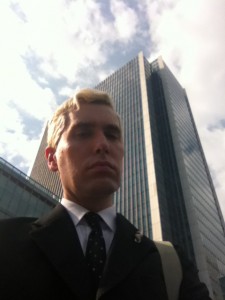
Next door to the skyscraper is Jubilee Park, built not on top of earth but over the roof of the tube station and shopping mall below. It is a roof garden at street level. A sign advertises a free performance of A Midsummer Night’s Dream this very evening.
The Clifford Chance building is straight out of a Christopher Nolan film. Outer walls of plate glass, pristine rooms of open-plan modernism, long toilets with mirrors at either end, doors that disappear into pine panels. I feel ready for my Inception fight scene.
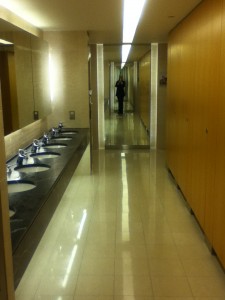
The clean lines apply to the people too: a strict dress code of ‘as smart as possible’. Dark suits for myself and the other male students. We look like we could all be in finance, even though many of us are in history, or science, or in my case, literature.
At the lobby I am given a badge (‘Dickon Edwards – BA English’) and a plastic visitor’s pass with which to best the security barriers. Then I’m escorted into an express lift, which zooms directly to the floor in question, ears threatening to pop.
The event is in a large, open room that forms the south-west corner of the thirtieth floor. Two of its walls are floor-to-ceiling windows commanding views over the Thames and beyond, particularly Greenwich to the south and Rotherhithe to the west. I can make out the red ball at the top of Greenwich Observatory, tiny yet clear on this bright summer day.
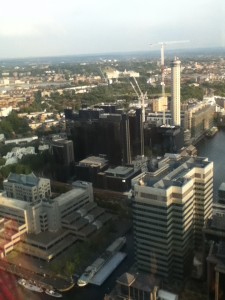
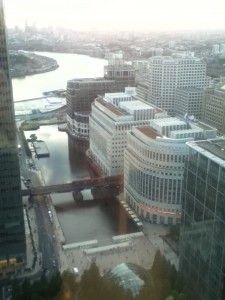
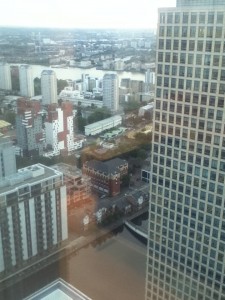
It is not the height that makes me giddy, but the apprehension of the city as achievement. What a piece of work is a man, indeed.
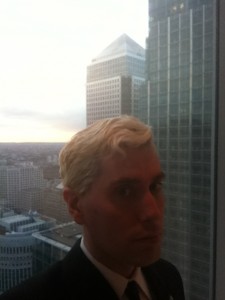
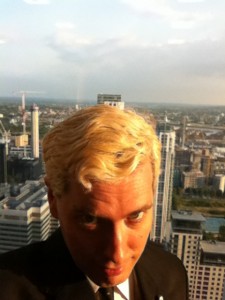
There’s about 150 people here. I don’t feel it’s right to approach them by myself, but thankfully there are Birkbeck staffers on hand who physically grab me and introduce me to donors and governors. I live in a rented bedsit and worry about being able to buy new shoes. Not only do these people have enough money to not live like that, but they choose to spend some of their spare money on helping people like me study for a degree. So tonight I feel up amongst the gods.
I meet the Birkbeck Master, David Latchman, who is effectively the boss. He’ll be the one presenting me with my degree next year, all being well. I also meet Tricia King, who is the Pro-Vice-Master for Student Experience, and Hilary Fraser, who is my more immediate boss, being as she is the Executive Dean of the School of Arts. I chat to some of the donors too, many of whom were once at Birkbeck themselves. One gentleman is from the steel firm ArcelorMittal, who funded the Orbit, the twisting sculpture-cum-watchtower in the Olympic Park. I tell him how it can be seen from as far away as Highgate Hill, and that I mean to go up it sometime, when it’s open again (the Olympic park was closed after the 2012 Games). He tells me it is open again. So I make a mental note to go to the Orbit soon, and to think of its connection with Birkbeck when I do.
Speeches are given, free wine is served. In her speech, Tricia King is kind enough to mention me and even point me out. The honorary President of Birkbeck, Baroness Joan Bakewell, then comes over to me (an important detail!) and congratulates me for coming back to education, and sticking with it.
I am asked if I can cram my story into a Tweet, allowing for the dutiful hashtag. I provide the following:
Birkbeck upgrades minds. I dropped out of A-levels; am dyspraxic & dyslexic. Now doing a BA English, getting 1st class marks. #BBKScholars.
Just before I leave, I look down over Jubilee Park next door, and see that the performance of A Midsummer’s Night Dream has begun. The symbolism is irresistible. Birkbeck has enabled me to literally look at literature from a position of empowerment.
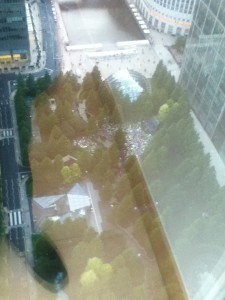
I go down to street level and watch some of the show. The production is a loose and fun version, featuring stuffed animal toys at one point. People are sitting around with picnics as the sun sets. Â This moment in the metropolis feels happy and peaceful, even Utopian; how a civilisation should be. A midsummer night’s urban dream.
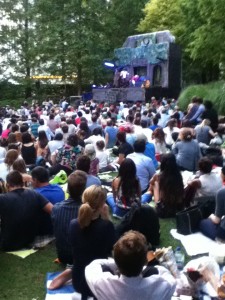
* * *
Tuesday 22nd July 2014. To the ICA for Finding Vivian Maier. It’s a film that’s been getting a lot of attention – posters on the tube even, unusual for what is essentially a BBC4-type arts documentary. It tells the story of the amateur street photographer of the title, who despite being immensely prolific died without ever displaying her work.
The story starts with her negatives being bought in a garage sale by the young man who narrates the film. He has them printed, and is startled by the quality of the work, yet cannot find a mention of her on Google (that very modern reflex action, now part of life, and so part of movies). So begins his double campaign: to have Vivian Maier’s photographs brought to public attention, and to find out why she didn’t do this herself. The film takes in all kinds of issues, such as the connection between ‘eccentricity’ and mental health, the role of live-in nannies in families, and the strange rules some arts institutions have when defining art. One gallery tells the narrator that if a photographer didn’t print their own work, they cannot be regarded as a proper artist. He convincingly exposes the flaws in this argument, backing it up with instances of famous photographers who did have their work printed posthumously. The work is the image, not the print. Thank to this film, Vivian Maier has made her name at last. Even if she didn’t want to.
Tags:
birkbeck,
canary wharf,
foyles st pancras,
joan bakewell,
London,
muriel spark,
scholars evening,
vivian maier














